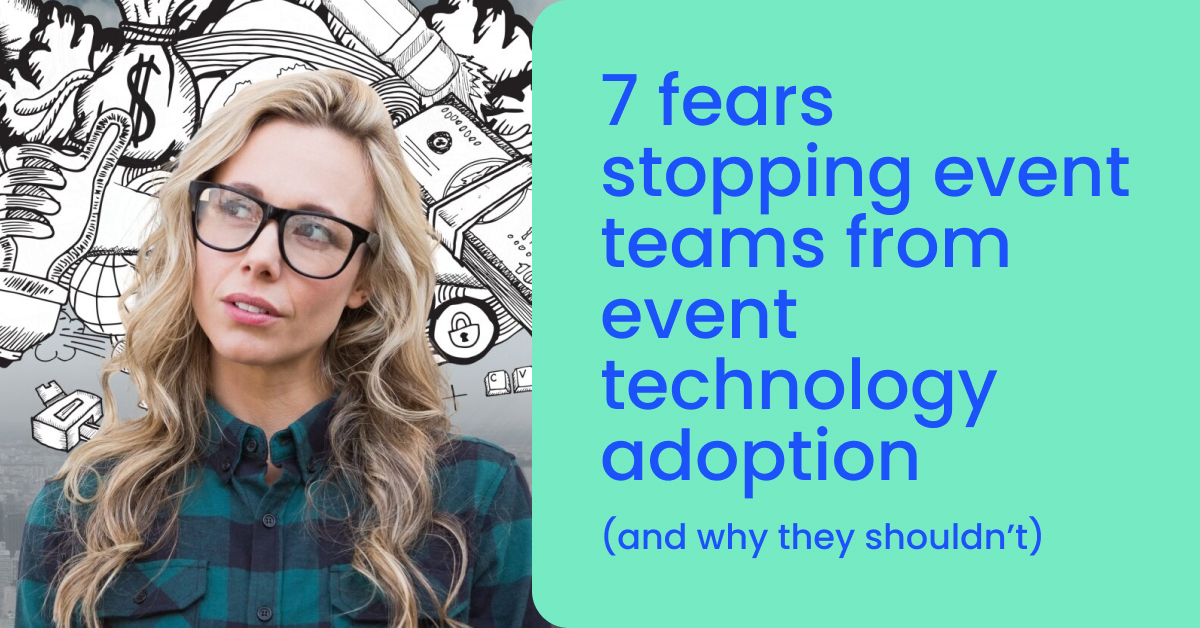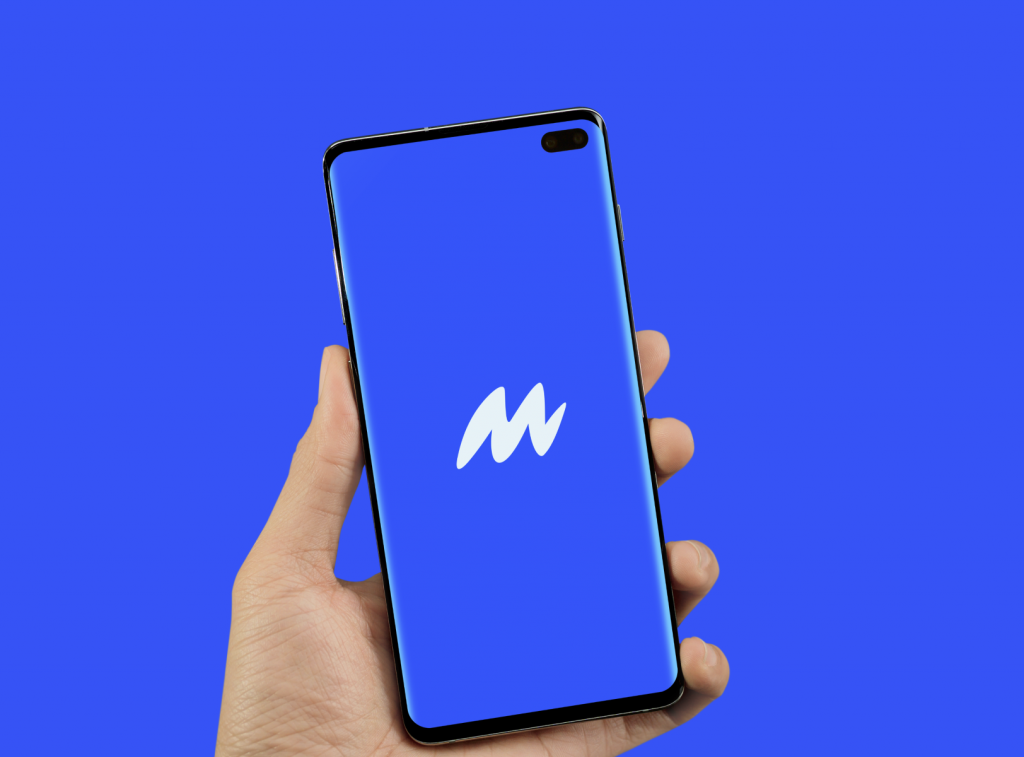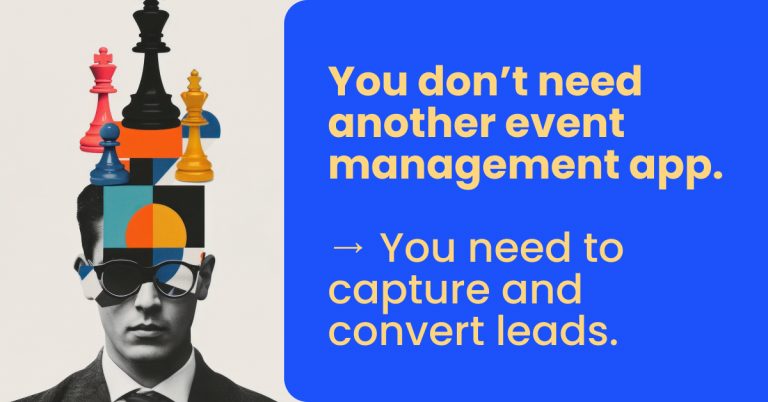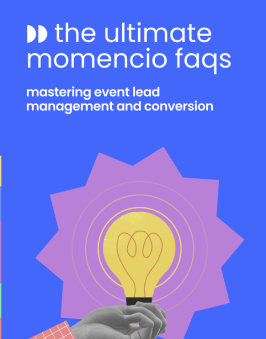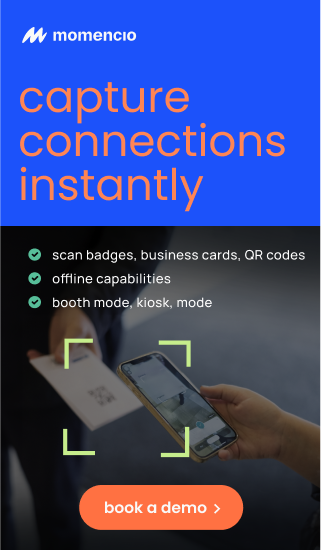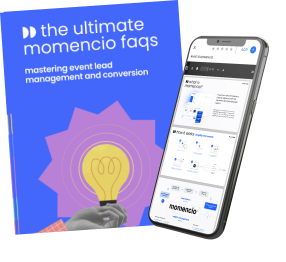Event teams operate in high-pressure environments, where precision and efficiency are critical. Despite this, many teams hesitate to embrace event management software and automation tools, fearing high costs, complex implementation, or team resistance. However, avoiding new technology means missing out on opportunities to streamline workflows, enhance attendee experiences, and drive higher event ROI.
TL;DR
Many event teams resist event technology adoption due to cost concerns, implementation fears, or resistance to change. However, modern event tech solutions are designed to be cost-effective, easy to use, and seamlessly integrated—ultimately improving ROI, attendee engagement, and team efficiency. Here’s how to overcome the top seven fears and unlock the full potential of event technology.
This article uncovers the seven biggest fears that stop event teams from adopting better tech—and why those fears shouldn’t hold you back.
Fear #1: “New tech is too expensive” – Breaking down cost vs. ROI
One of the biggest roadblocks to event technology adoption is the perception that new tools are too expensive. Many teams see tech investments as a budget drain rather than an ROI booster—but this perspective often ignores the long-term value and efficiency gains that modern event tech delivers.
The real cost of sticking to outdated methods
What’s truly expensive? Wasted time, lost leads, and inefficiencies that stem from manual processes. Consider these hidden costs of avoiding event tech:
- Lost opportunities: Without automated lead capture, event teams miss out on high-value prospects who might have converted with better follow-ups.
- Wasted labor hours: Manually entering data, coordinating event logistics, and tracking attendee engagement without digital tools consumes countless staff hours that could be better spent on strategy and execution.
- Missed revenue potential: Events that fail to leverage real-time engagement analytics often struggle to measure ROI, leading to poor decision-making for future events.
Tech adoption: A revenue multiplier, not a cost center
Rather than viewing event tech solutions as a cost, successful event teams recognize them as a force multiplier that drives efficiency, revenue, and attendee satisfaction. Here’s how:
- Higher lead conversion rates: Automated follow-ups and CRM integrations ensure no lead is lost, resulting in more closed deals post-event.
- Better data insights: Advanced analytics provide real-time attendee engagement metrics, helping teams optimize event experiences and improve ROI.
- Reduced labor costs: Automation minimizes repetitive manual work, allowing teams to focus on high-impact tasks instead of data entry.
Smart investments: Finding tech that fits your budget
The good news? Not all event tech solutions require massive upfront investments. Many platforms offer:
✅ Scalable pricing plans, allowing teams to start small and expand as needed.
✅ Free demos, enabling teams to test functionality before committing.
✅ Cloud-based tools, eliminating the need for costly hardware or infrastructure.
The bottom line
When evaluating event technology adoption, don’t just look at the price tag—look at the savings, efficiencies, and revenue impact it delivers. Investing in the right tools can help streamline operations, maximize engagement, and drive measurable ROI, making it one of the smartest financial decisions an event team can make.
Fear #2: “It’s too complicated to implement” – How modern solutions simplify onboarding
One of the most common fears surrounding event technology adoption is the idea that implementing new tools is too complex. Teams worry about long training periods, disruptions in their workflow, and the dreaded “learning curve.” The good news? Modern event tech is designed to be intuitive, user-friendly, and easy to implement.
The myth of complex implementation
Many event professionals still associate new technology with outdated, difficult-to-use software that requires weeks—if not months—of training. However, today’s event tech solutions prioritize simplicity with:
- Plug-and-play setups that require little to no IT involvement.
- Cloud-based platforms that eliminate the need for complex installations.
The reality: Event tech companies make onboarding seamless
The best event tech providers understand that time is money, which is why they offer:
✅ Dedicated onboarding specialists to walk teams through setup.
✅ Step-by-step video tutorials that make learning convenient..
✅ Live chat and documentation to answer common questions.
How long does it really take to implement event tech?
Most modern event management platforms can be fully implemented in a matter of days—not months. A well-structured onboarding plan ensures that teams can start using the software within hours.
Quick implementation examples:
- Lead capture tools can be deployed in under an hour and integrated into existing workflows immediately.
- Event registration platforms take just a few clicks to set up and personalize.
- AI-powered automation eliminates repetitive tasks, allowing teams to focus on strategy instead of setup.
The fear of disrupting existing workflows
A major concern among event teams is that implementing new technology will disrupt their current workflows and slow down productivity. The truth? Event tech is built to integrate seamlessly into existing systems, making transitions smooth and effortless.
Many tools integrate directly with:
- CRM platforms like HubSpot and Salesforce to sync lead data automatically.
- Marketing automation tools for seamless email follow-ups.
ROI-focused implementation: The faster you adopt, the sooner you see results
Think about it: The longer your team waits to adopt event tech, the longer you’ll continue struggling with inefficiencies, lost leads, and outdated processes. The faster your team integrates new tools, the faster you’ll experience:
- Higher attendee engagement with personalized event experiences.
- More efficient workflows that save time and reduce stress.
- Stronger event performance metrics that lead to smarter decision-making.
The bottom line
Event technology adoption doesn’t have to be complicated. With today’s user-friendly platforms, dedicated support, and seamless integrations, implementation is easier, faster, and more effective than ever before. Teams that embrace new tools experience less stress, more efficiency, and better event outcomes.

Fear #3: “Our team won’t use it” – Overcoming resistance with intuitive tools
Even the best event tech solutions are useless if teams don’t adopt them. A major concern for event organizers is that employees won’t use the new technology, either because they find it too complicated, they’re resistant to change, or they don’t see the value in it. But the truth is, when technology is intuitive, beneficial, and easy to use, teams not only adopt it—they embrace it.
The resistance to change: Why teams push back
Employees often resist new tools because they fear:
- Added workload: They assume the software will create extra tasks rather than simplify their work.
- Steep learning curves: Many believe they’ll have to spend weeks figuring out the system.
- Loss of control: Some worry that automation will replace their role or take away decision-making power.
How to drive adoption: Make tech work for them, not against them
Technology adoption isn’t just about introducing a new tool—it’s about showing your team how it makes their jobs easier. Here’s how successful event teams ensure high adoption rates:
- Select user-friendly platforms: The best event tech solutions are designed with intuitive interfaces and familiar navigation, making them easy for anyone to use.
- Highlight personal benefits: Instead of focusing on company-wide benefits, emphasize how the tool reduces stress, eliminates repetitive tasks, and helps employees work smarter.
- Use champions within your team: Identify early adopters who can advocate for the technology and train others. When employees see peers benefiting from the software, they’re more likely to jump on board.
Training without the headache: Making onboarding effortless
Many event tech providers offer step-by-step onboarding, and personalized support, making the learning process simple. Some best practices include:
✅ Hands-on training sessions that let employees test the platform before an event.
✅ On-demand video tutorials for self-paced learning.
✅ Gamification strategies, like rewards for early adoption and successful implementation.
The psychology of adoption: People fear the unknown, not the tech
Many people don’t resist technology itself—they resist what they don’t understand. By introducing event tech gradually, demonstrating quick wins, and showing how it integrates into existing workflows, teams quickly become comfortable and confident using it.
What happens when teams embrace event tech?
Once an event team fully adopts new technology, the results are undeniable:
- 30-40% increase in productivity as automation handles manual tasks.
- Higher attendee engagement thanks to data-driven insights.
- More strategic decision-making using real-time analytics.
The bottom line
Teams resist change when they don’t understand how it benefits them. By choosing intuitive platforms, emphasizing personal benefits, and offering strong training support, event organizers can ensure high adoption rates and long-term success with new technology.
Tip: Download our full “13 questions you might get about switching to momencio—And how to answer them” guide to help make the case internally.
Fear #4: “What if the tech fails during the event?” – Ensuring reliability and support
Technology failures are every event planner’s nightmare. Whether it’s Wi-Fi issues, software glitches, or hardware malfunctions, the fear of tech failure prevents many teams from fully embracing event technology adoption. However, with proper planning, redundancies, and support systems, technology can be one of the most reliable assets in an event team’s toolkit.
Why the fear of tech failure is overblown
While no technology is 100% failproof, modern event tech solutions are designed with reliability and backup systems to ensure minimal disruptions. Here’s why event teams should trust in technology rather than fear it:
- Cloud-based event solutions mean no risk of data loss, even if local devices fail.
- Automated backups ensure that essential attendee data and event schedules are never lost.
- 99.9% uptime guarantees from top event tech providers ensure smooth operations.
How to ensure reliability: Proactive measures
Event planners can minimize risks by choosing technology with proven reliability and having fail-safe strategies in place. Here’s how:
✅ Invest in tech with strong customer support: Ensure the provider offers 24/7 assistance, live chat, and real-time troubleshooting.
✅ Run pre-event tests: Simulating real-world conditions can help detect and fix potential issues before they impact attendees.
✅ Have contingency plans: Keep backup power sources, secondary internet connections, and alternative devices ready.
✅ Train your team: Equip staff with the knowledge to troubleshoot minor issues without waiting for external support.
What happens when event tech works seamlessly?
When teams trust their technology and plan ahead, they experience:
- Faster check-ins with seamless registration software.
- Real-time data tracking without system delays.
- Flawless presentations without interruptions.
The bottom line
Tech failure is only a risk if teams don’t plan for it. With proactive testing, backup solutions, and vendor support, event tech is actually one of the most dependable tools an event team can have.
Fear #5: “It won’t integrate with our existing systems” – Why seamless integration is easier than ever
Many event teams fear that new technology won’t work with their existing systems, creating data silos, inefficiencies, and additional work. However, modern event tech solutions are designed to integrate effortlessly with the tools and platforms organizations already use.
The reality: Seamless integration is now the standard
Event technology providers understand that disrupting existing workflows is a deal-breaker. That’s why most modern platforms are built with open APIs, plug-and-play functionality, and native integrations that make merging new tools with existing systems effortless.
✅ CRM integrations: Connect seamlessly with HubSpot, Salesforce, and other CRM platforms to sync attendee and lead data in real time.
✅ Marketing automation compatibility: Ensure your event data flows into email campaigns, lead nurturing sequences, and social media tracking.
✅ Analytics dashboards: Consolidate event insights with BI tools like Google Analytics or Tableau for smarter decision-making.
What happens when tech integrates smoothly?
When event technology works hand in hand with existing systems, teams experience:
- Streamlined workflows where data moves automatically between platforms.
- More accurate reporting with real-time syncing of lead and attendee activity.
- Higher efficiency as teams spend less time on manual data entry.
How to ensure a smooth integration process
To guarantee new technology integrates seamlessly, event teams should:
- Choose tech with proven integrations: Look for platforms that explicitly support your existing tools to minimize compatibility issues.
- Use automation tools: Platforms like Zapier help connect event software with hundreds of applications, creating smooth data transfers.
- Leverage vendor support: Work closely with event tech providers to configure integrations and troubleshoot issues during setup.
The bottom line
The fear of poor integration is outdated. Today’s event tech solutions are built to work together, ensuring seamless workflows, real-time data access, and improved efficiency. By choosing the right platforms, event teams can create a connected ecosystem that enhances productivity and maximizes ROI.
Fear #6: “We’ve always done it this way” – Breaking free from outdated methods
One of the biggest barriers to event technology adoption isn’t budget or complexity—it’s tradition. Many event teams rely on the same workflows, processes, and tools they’ve used for years, believing that if it’s not broken, there’s no need to fix it. However, sticking to outdated methods comes at a high cost, leading to inefficiencies, lost opportunities, and falling behind competitors who embrace innovation.
Why tradition holds event teams back
While familiarity is comfortable, it can also be limiting. Teams who refuse to adopt event tech solutions may struggle with:
- Inefficient manual processes that slow down event planning and execution.
- Limited attendee engagement due to a lack of personalization and digital interaction.
- Poor data tracking that makes it difficult to measure event success and ROI.
- Higher operational costs as resources are wasted on outdated workflows.
Embracing change: The advantages of modern event technology
Event professionals who embrace event automation, digital event tools, and AI-driven solutions see a dramatic increase in efficiency, engagement, and ROI. Benefits include:
✅ Automated workflows that eliminate repetitive tasks and improve productivity.
✅ Real-time engagement tracking to understand attendee behavior and preferences.
✅ Smart data analytics to make informed, strategic decisions for future events and trade shows.
✅ Cost savings by reducing reliance on outdated, labor-intensive processes.
How to overcome resistance to change
Transitioning from legacy systems to modern event management software doesn’t have to be overwhelming. Teams can ease into change with a structured approach:
- Start small: Implement one or two tech solutions at a time to avoid overwhelming the team.
- Showcase quick wins: Highlight immediate benefits, such as time saved and improved accuracy.
- Encourage feedback: Involve team members in selecting and adapting new technologies to ensure buy-in.
- Provide hands-on training: Equip teams with the knowledge and confidence to use new tools effectively.
The risk of staying the same
The events industry is evolving faster than ever, with new digital event tools and automation platforms reshaping the way organizers operate. Teams that fail to adapt risk falling behind and losing attendees, sponsors, and valuable business opportunities to more tech-savvy competitors.
The bottom line
Tradition may feel comfortable, but it’s not a strategy for growth. Event teams that embrace event technology adoption are more efficient, data-driven, and competitive in today’s fast-paced industry. Change doesn’t have to be disruptive—it just has to be strategic.
Fear #7: “We don’t have time to learn something new” – How automation saves time in the long run
A common objection to event technology adoption is the belief that learning a new system will take too much time. Many event teams, already stretched thin, assume that adopting event automation and digital event tools will add more work to their plates instead of reducing their burden. However, the reality is that automation saves time, reduces workload, and increases efficiency—making it one of the most valuable investments a team can make.
The cost of sticking with manual processes
Without automation, event teams spend countless hours on manual tasks such as:
- Data entry for lead information, attendee check-ins, and feedback collection.
- Follow-up emails that need to be drafted, customized, and sent one by one.
- Scheduling meetings and appointments manually instead of using integrated tools.
- Compiling reports from multiple spreadsheets and disconnected sources.
These repetitive tasks drain productivity, increase human error, and reduce time spent on strategic planning and attendee engagement.
How event automation saves time
By automating routine processes, event teams can significantly reduce workload while improving accuracy and effectiveness. Some key benefits include:
✅ Automated lead capture & CRM syncing: No more manually entering attendee details—event tech integrates directly with CRM platforms, saving hours of admin work.
✅ Instant follow-up sequences: Personalized post-event emails can be automatically triggered based on attendee interactions.
✅ AI-powered insights: Instead of spending hours analyzing event performance, dashboards provide real-time reports that highlight key metrics instantly.
The learning curve myth: Event tech is designed for ease of use
Another misconception is that learning new tech is complicated and time-consuming. However, modern event solutions are designed to be:
- User-friendly with intuitive dashboards that require little to no training.
- Supported by onboarding programs, tutorials, and customer support teams that ensure smooth adoption.
- Customizable with automation templates that eliminate the need for manual setup.
Fast adoption = Immediate benefits
Instead of taking months to learn, most event teams can fully implement and start benefiting from event automation within days. A simple shift toward automation leads to:
- 50% faster task completion, allowing teams to focus on high-impact initiatives.
- More accurate data tracking without the hassle of spreadsheets.
- Better attendee engagement through personalized automation.
The bottom line
Time constraints shouldn’t be an excuse to avoid event technology adoption—they should be the reason to embrace it. Automation and digital event tools reduce manual work, free up time, and enhance efficiency, making events more successful with less effort.

Embracing event technology leads to better ROI, efficiency, and engagement
At its core, event technology adoption is not about replacing human expertise—it’s about enhancing efficiency, improving accuracy, and creating better experiences for attendees. The fears surrounding event tech are understandable, but when examined closely, they are outdated, exaggerated, or easily solvable.
The competitive advantage of embracing event tech
Companies that adopt event tech solutions experience:
✅ Higher ROI through better lead tracking, automation, and data-driven decision-making.
✅ More engaged attendees due to real-time personalization and seamless event experiences.
✅ Faster workflows that free up teams to focus on strategy rather than admin work.
✅ Improved scalability for handling larger events without increasing overhead.
Innovation isn’t optional—it’s essential
The events industry is rapidly evolving, and sticking to old methods is no longer sustainable. Event professionals who embrace technology position themselves as industry leaders, offering better experiences to attendees, partners, and sponsors while driving more revenue from their events.
The question is no longer “Should we adopt event technology?” but rather “How quickly can we implement it to stay ahead?” By addressing fears with facts, planning, and the right tools, event teams can make technology their greatest competitive advantage.
Interesting facts from research
Event technology adoption is transforming the industry, and the numbers prove it. Research highlights the direct correlation between tech-driven event strategies and improved engagement, efficiency, and revenue. Here are some compelling statistics that reinforce why embracing event tech is essential:
1. Event tech boosts ROI and revenue
- 81% of event organizers say event technology has a major impact on the success of their events.
- Companies that use event automation tools see a 27% increase in event ROI compared to those that rely on manual processes.
- Organizations that leverage real-time event data are 5x more likely to achieve their revenue goals.
2. Faster follow-ups lead to higher conversions
- 78% of customers buy from the first company that follows up with them after an event.
- Automated lead capture and CRM syncing can reduce follow-up times by 80%, dramatically increasing conversion rates.
3. Attendee engagement skyrockets with tech-driven experiences
- 68% of event attendees say they engage more when digital tools like event apps, live polls, and AI-powered matchmaking are available.
- Personalized event experiences powered by AI lead to a 32% increase in attendee satisfaction.
4. Automation reduces time and costs
- Event planners spend 40% less time on administrative tasks when using automation.
- Companies that implement event tech solutions cut labor costs by up to 30% while improving efficiency.
- AI-powered event management platforms save organizers 20+ hours per event by streamlining operations.
5. The future is tech-driven—adoption is no longer optional
- 86% of event professionals believe event technology will be critical to success within the next five years.
- 70% of companies plan to increase their investment in event technology in the next two years.
- The global event technology market is expected to grow to $18 billion by 2026, emphasizing the rapid adoption across industries.
The takeaway: Event tech isn’t just a trend—it’s the key to staying competitive
The data speaks loud and clear: event professionals who leverage technology see greater success, increased efficiency, and stronger attendee engagement. Those who resist are not only losing time but also missing out on massive growth opportunities.
FAQs – Answering the biggest questions about event technology adoption
- What is event technology adoption, and why does it matter?
- Event technology adoption refers to the integration of digital tools and automation into event planning, execution, and follow-up processes. It matters because it increases efficiency, improves attendee engagement, and maximizes event ROI. Without it, teams risk falling behind competitors who leverage technology for better results.
- How do I know if my event team is ready for new technology?
- If your team struggles with manual data entry, slow follow-ups, limited attendee insights, or disconnected tools, it’s a sign that new technology can help. Even small tech implementations—like automated lead capture or AI-driven analytics—can create massive improvements without overwhelming your team.
- Will event technology replace the human element in events?
- Not at all! Event tech enhances human interaction rather than replacing it. Automation handles repetitive tasks, allowing teams to focus more on engagement, networking, and strategic decision-making. Technology simply makes human-driven events more efficient and impactful.
- What’s the ROI of investing in event technology?
- Studies show that event technology adoption leads to:
- 27% increase in event ROI
- 40% reduction in time spent on manual tasks
- 3x higher attendee engagement through digital interactions
- The key is choosing the right technology that aligns with your event goals.
- Studies show that event technology adoption leads to:
- How long does it take to implement event technology?
- Most modern event tech solutions are plug-and-play, meaning they can be set up and operational within days, not months. Cloud-based tools with intuitive dashboards and minimal training requirements make the transition smoother than most teams expect.
- How do I get my team on board with new technology?
- Change can be challenging, but adoption rates improve when you:
- Showcase quick wins (e.g., how automation saves hours of work).
- Provide hands-on training and let teams explore the platform.
- Choose user-friendly tech with minimal learning curves.
- Identify internal champions who can encourage peers to use the tools effectively.
- Change can be challenging, but adoption rates improve when you:
- What if my company has a limited budget for event tech?
- You don’t need a massive budget to start leveraging event technology. Many platforms offer:
- Flexible pricing models (pay-as-you-go or scalable plans).
- Free trials to test functionality before committing.
- Automation tools that generate savings by reducing manual labor costs.
- Even a small investment in event automation or lead capture solutions can yield significant efficiency gains.
- You don’t need a massive budget to start leveraging event technology. Many platforms offer:
- What’s the future of event technology?
- The future of event technology is AI-driven, automated, and hyper-personalized. Expect innovations like:
- AI-powered matchmaking to connect attendees more effectively.
- Predictive analytics to improve event planning and marketing.
- Smart chatbots & virtual assistants to enhance attendee engagement.
- The future of event technology is AI-driven, automated, and hyper-personalized. Expect innovations like:
Conclusion
The world of event planning is evolving, and those who embrace technology gain a clear competitive edge. The fears that hold teams back—from cost concerns to implementation challenges—are often based on outdated assumptions. The reality is that event technology adoption leads to higher efficiency, better attendee engagement, and a measurable boost in event ROI.
The cost of inaction
By refusing to adapt, event teams risk wasting time on manual processes, missing valuable leads, and falling behind competitors who are leveraging automation and data-driven insights. Event professionals who resist technology today may find themselves struggling to stay relevant in an increasingly tech-driven industry.
Taking the first step toward event technology adoption
If your team is ready to streamline operations, improve engagement, and boost event performance, start with small, high-impact tech solutions:
✅ Automated lead capture to eliminate manual data entry.
✅ Event apps that enhance attendee interaction.
✅ AI-powered analytics to measure event success and optimize future strategies.
✅ CRM integration for seamless follow-ups and higher conversions.
Let technology work for you
Event technology isn’t here to complicate your workflow—it’s here to simplify it, maximize efficiency, and drive results. The sooner your team takes the leap, the faster you’ll experience the time savings, engagement boosts, and revenue growth that come with smart event tech solutions.
